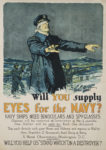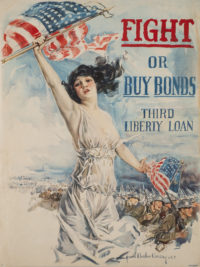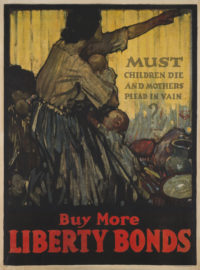 Saturday, January 27th, is World War I Digitization Day in Greenwich, Connecticut. An initiative of the Connecticut State Library, the Digitization Days program gives state residents the opportunity to memorialize people who played a role in the War to End All Wars by digitizing their images, documents, letters and medals and sharing the stories handed down from generation to generation over the course of the last 100 years. Local museums have been opening their doors to the public so that they can contribute their objects and lore to build a digital archive of World War I.
Saturday, January 27th, is World War I Digitization Day in Greenwich, Connecticut. An initiative of the Connecticut State Library, the Digitization Days program gives state residents the opportunity to memorialize people who played a role in the War to End All Wars by digitizing their images, documents, letters and medals and sharing the stories handed down from generation to generation over the course of the last 100 years. Local museums have been opening their doors to the public so that they can contribute their objects and lore to build a digital archive of World War I.
 The Bruce Museum in Greenwich, Connecticut, is hosting a Digitization Day event from 12:00-4:00 PM this Saturday in conjunction with its newly opened exhibition Patriotic Persuasion: American Posters of the First World War. Visitors are welcome to bring their photos, papers and keepsakes from WWI to the museum where they will meet with a digitization specialist who will gather all information known about the loved one connected to the objects and scan up to five items on the spot. No need to fear that your family treasures will disappear down the rabbit hole or be out of your hands for months. Everything is done using portable equipment in front of your very eyes. Once the scanning is done, you get your stuff back and a link to where the scans have been uploaded online. All of the digitized material will be added to the Connecticut State Library’s digital collection where it is freely available to the public.
The Bruce Museum in Greenwich, Connecticut, is hosting a Digitization Day event from 12:00-4:00 PM this Saturday in conjunction with its newly opened exhibition Patriotic Persuasion: American Posters of the First World War. Visitors are welcome to bring their photos, papers and keepsakes from WWI to the museum where they will meet with a digitization specialist who will gather all information known about the loved one connected to the objects and scan up to five items on the spot. No need to fear that your family treasures will disappear down the rabbit hole or be out of your hands for months. Everything is done using portable equipment in front of your very eyes. Once the scanning is done, you get your stuff back and a link to where the scans have been uploaded online. All of the digitized material will be added to the Connecticut State Library’s digital collection where it is freely available to the public.
 Everyone who comes to the museum with materials to digitize will be given free admission (tickets usually cost $10), so once you’ve chipped in your family history to the wider story of the state and country’s participation in the Great War, you can enjoy a gratis view of the Bruce Museum’s collection of World War I propaganda posters donated to the museum by Beverly and John W. Watling III in 2008.
Everyone who comes to the museum with materials to digitize will be given free admission (tickets usually cost $10), so once you’ve chipped in your family history to the wider story of the state and country’s participation in the Great War, you can enjoy a gratis view of the Bruce Museum’s collection of World War I propaganda posters donated to the museum by Beverly and John W. Watling III in 2008.
The United States’ involvement in World War I lasted only 20 months, from April 1917 to November 1918, but the nation’s military and propaganda strategies were of enormous consequence. In the era of radio and film’s infancy, posters were an essential medium; there were more than 20 million posters printed from about 2,500 designs.
Many of the posters on display in Patriotic Persuasion were originally collected by Mr. Watling’s stepfather, Charles B. Warren, Jr., and his brother, Wetmore Warren, in Washington, D.C., where their father, Charles B. Warren, served on the staff of the Judge Advocate General during the war.
The variety of approaches that government agencies used to encourage widespread participation in the war effort was impressive, from the allure of artist Howard Chandler Christy’s young woman who, in a 1917 poster, seductively proclaimed, “I Want You for the Navy,” to the inquisitional tone of a war loan poster of the next year: “Are you 100% American? Prove it! Buy U.S. Government Bonds.”
Other posters combine image and text in ingenious, surprising, and sometimes disturbing combinations. In one of the iconic wartime posters from 1918, artist Joseph Pennell powerfully imagined a partially destroyed Statute of Liberty and New York City aflame in the background, with the plea, “That Liberty Shall Not Perish from the Earth / Buy Liberty Bonds / Fourth Liberty Loan.”
“This show represents a hallmark of the Bruce — to develop creative ways to showcase our collection in meaningful exhibitions that link artistic works with human history on a global and local scale,” says Kirsten Reinhardt, museum registrar. “These posters were displayed all over the country, including in Greenwich, and the power of their message remains strong today.”
 I will be traveling to the Digitization Days event with a relative who has an extraordinary group of medals and medallions, including several that were given to women who were recognized for their bravery and humanitarian contributions when the war was its most bloody. I am honored to see the objects and the stories behind them become part of the archive and hope we can learn more about them than the very little we know now. The medals are somewhat obscure and one of the diplomas that came with them has survived. After all these years blogging about digitization projects and crowdsourced data and archive collections, finally I get to see it happen live, and to help a family member find out all she can about these fascinating pieces to boot.
I will be traveling to the Digitization Days event with a relative who has an extraordinary group of medals and medallions, including several that were given to women who were recognized for their bravery and humanitarian contributions when the war was its most bloody. I am honored to see the objects and the stories behind them become part of the archive and hope we can learn more about them than the very little we know now. The medals are somewhat obscure and one of the diplomas that came with them has survived. After all these years blogging about digitization projects and crowdsourced data and archive collections, finally I get to see it happen live, and to help a family member find out all she can about these fascinating pieces to boot.

